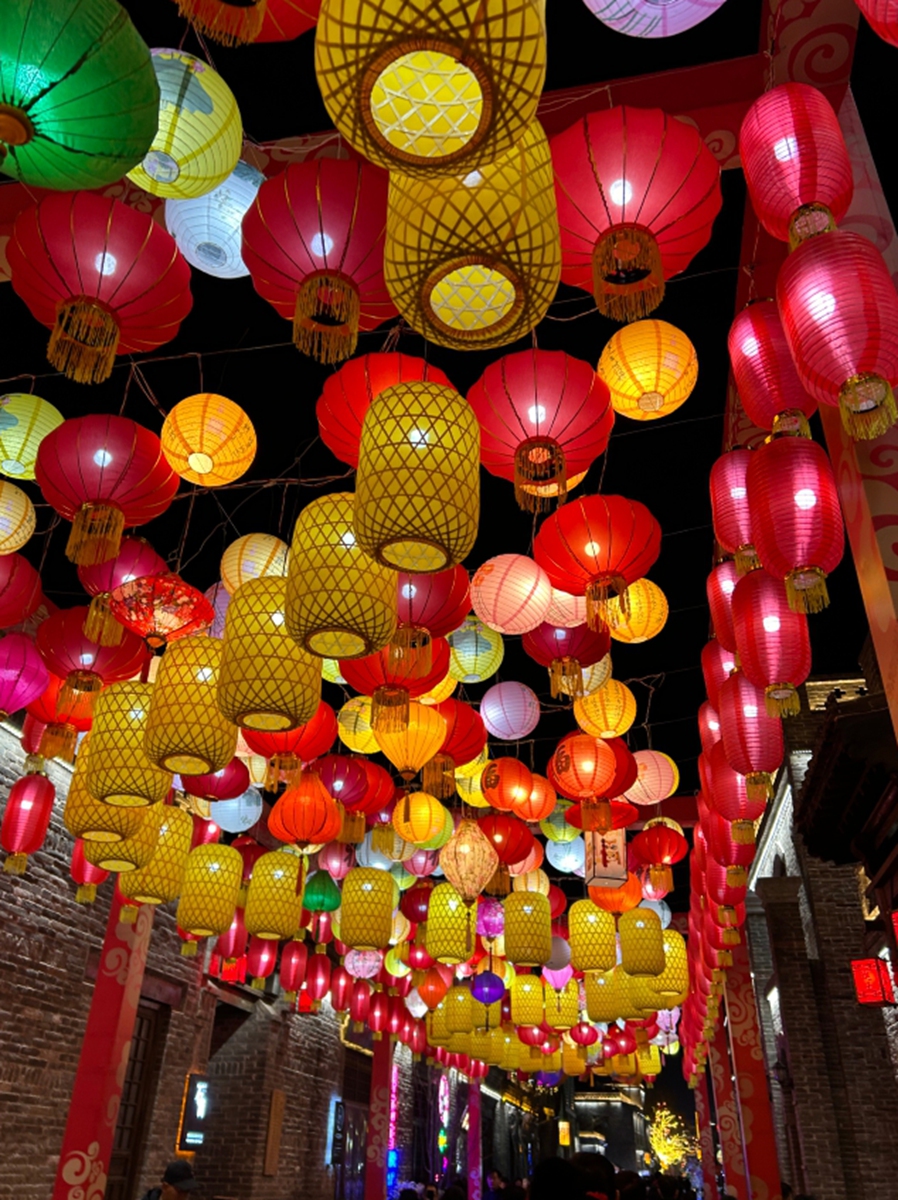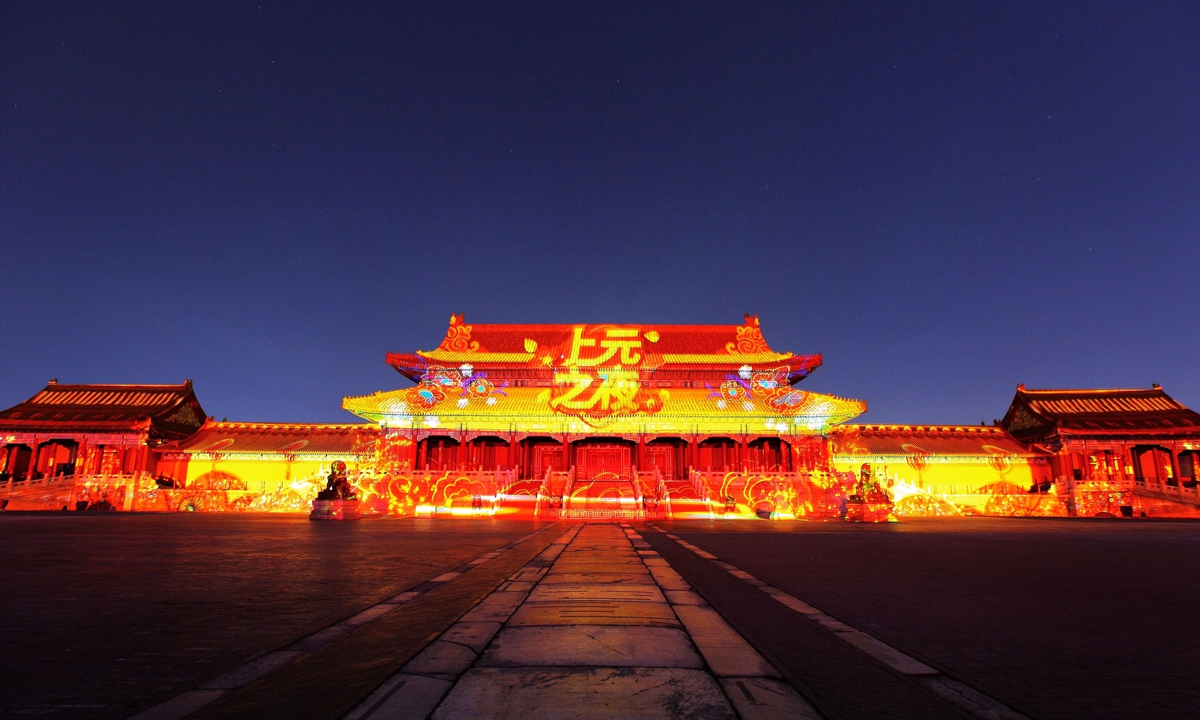
Festival lanterns decorate an ancient alleyway in Handan, Hebei Province. Photo: Li Qian/GT
Editor's Note:The atmosphere of the Chinese Spring Festival reaches a climax with the arrival of the Lantern Festival, the 15th day of the first lunar month. Over its 2,000-year development, the festival has acquired a number of different meanings as people come together with their family to appreciate the moon, light lanterns, watch various performances and enjoy the delicacy of the traditional glutinous rice balls. The Lantern Festival in ancient China was also a time for young men and women to meet with each other and fall in love.
This introduction to the Lantern Festival is written by Xu Liuliu, Chen Xi and Wu Jie.
Chinese romance
Last Festival of Vernal Moon,
the blooming lanterns bright as noon.
The moon above a willow tree,
shone on my lover close to me.
This Festival comes now again,
the moon and lanterns bright as then.
But where's my lover of last year?
My sleeves are wet with tear on tear.
This 1,000-year-old poem, written by famed poet Ouyang Xiu during the Song Dynasty (960-1279), highlights the romance of this festival.
Originating from the Han Dynasty (206BC-AD220), the Lantern Festival officially became a national-level festival during the Tang Dynasty (618-907). By the Song Dynasty, the festivities expanded further with the introduction of activities such as solving lantern riddles, which became an integral part of the festival.
In the feudal society of ancient China, young women were not encouraged to go out freely except during the Lantern Festival.
During the Sui Dynasty (581-618), the emperor would ascend a tower to admire the exuberant lanterns on display during the festival accompanied by his concubines.
By the Tang Dynasty, the Lantern Festival became a three-day holiday, with the lifting of curfews allowing people to go out and enjoy the lanterns at night. Women were also allowed to mingle in the bustling crowds. During the early reign of Emperor Xuanzong of Tang, known as the Kaiyuan era, the lantern market in capital Chang'an was enormous. According to historical record, the giant lantern towers built according to the specifications of the emperor reached 150 feet in height, and the capital would light 50,000 lanterns of different styles for the celebration.
During the Song Dynasty, the Lantern Festival was even more prosperous and lively, with a stronger national character and wider participation among the people. The holiday was extended by another two days. Young men and women during the Song Dynasty were more romantic, able to meet with their lovers, express their affection, and exchange tokens of love. During the Southern Song Dynasty, literati and scholars wrote riddles on silk lanterns for people to guess, adding a more jubilant atmosphere to the festivities.
Despite the fact that curfews were in place during most Chinese dynasties, people were allowed to stay out late around the Lantern Festival.
Various romantic stories have been recorded in Chinese literature. In the thousands of ancient poems that have been passed down from the Tang and Song dynasties, many depict ardent love for their partners during the Lantern Festival. The festive atmosphere, the performances, and the moonlight jointly created the best time for a romantic moment and a perfect family union.

Kids have glutinous rice balls which are called yuanxiao, or tangyuan, in China. Photo: VCG
Celebratory snacks
The glutinous rice balls called yuanxiao or tangyuan is an indispensable snack for the Lantern Festival. Under the first full moon of the Chinese New Year, family members gather together to enjoy the round balls typically stuffed with sweet fillings such as sesame paste, red bean paste, or peanuts. Tangyuan is commonly served in sweet syrup.
In Chinese culture, round food such as yuanxiao symbolizes completeness and unity. Eating rice balls that resemble the full moon with family and friends signifies coming together and enjoying the warmth of togetherness, showing people's wishes for a joyous and prosperous year ahead, filled with happiness, reunion, peace, and good health.
Originating from a folk custom back in the Spring and Autumn Period (770BC-476BC), eating yuanxiao is a meaningful and joyous tradition that reinforces familial bonds, promotes harmony, and brings good fortune for the new year. The sweet fillings are believed to bring sweetness and happiness into one's life.

The Palace Museum is illuminated during its first light show for the Lantern Festival. Photo: VCG
Cultural inheritance
In a nod to the dazzling lantern fairs dating back to Han Dynasty, every Lantern Festival is nowadays celebrated around the country with lantern fairs.
In 2019, a grand lantern night was held at the Palace Museum in Beijing during the Lantern Festival. This marked the first-ever Lantern Festival held at the Palace Museum and also the inaugural large-scale illumination of the ancient architectural complex of the Forbidden City at night.
The innovative interactive light installations and art displays that incorporated modern technology such as LED lights and projection mapping allowed people to engage with the tradition in unique ways.
Currently, in addition to creative lantern fairs staged in cities across China, people enjoy getting dressed in traditional clothing such as hanfu to join festive parties in their communities.
Like the romantic occasion in ancient China, the festival now remains a social opportunity where young people opt to play card games or take part in lifestyle fairs and workshops to connect with each other.
The cultural exchanges or workshops that showcase traditional Lantern Festival customs, such as lantern-making techniques, storytelling sessions about the festival's origins, or performances of traditional music and dance are playing a crucial role in carrying on the legacy of the festival.
URL: https://www.seeglobalnews.com/read-3212.html